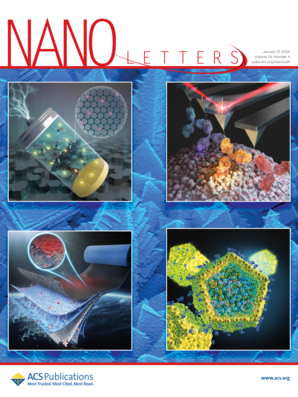三维纳米结构实现卡西米尔力控制
IF 9.6
1区 材料科学
Q1 CHEMISTRY, MULTIDISCIPLINARY
引用次数: 0
摘要
卡西米尔力控制着亚微米距离的固体物体之间的相互作用,并且通常限制了微机械设备失效前的最小距离。在这里,我们通过实验绕过这一限制,通过工程三维纳米结构控制卡西米尔力。利用我们最近开发的方法在纳米尺度上对准和测量两个微尺度物体之间的力,我们表征了球体与圆形柱、空心圆柱体和周期性柱阵列之间的力梯度。我们证明,在这些几何形状中,力的行为可以被显著地改变,导致单柱的卡西米尔力被抑制了10倍。我们发现理论和实验之间是一致的,即使物体的大小与表面到表面的分离相当(即在~ 3的因子范围内)。我们预计,我们的研究结果将影响未来微纳米级致动器的设计,提高灵敏度和减少粘连的光机械设备,以及先进的仿生粘合剂。本文章由计算机程序翻译,如有差异,请以英文原文为准。

Casimir Force Control Enabled by 3D Nanostructures
The Casimir force dominates interactions between solid objects at sub-micrometer distances and typically limits the smallest distance between micromechanical devices before failure. Here, we experimentally circumvent this limitation by controlling the Casimir force with engineered 3D nanostructures. Using our recently developed method to align and measure the force between two microscale objects on the nanoscale, we characterized the force gradient between spheres and circular pillars, hollow cylinders, and periodic pillar arrays. We demonstrate that the force behavior can be dramatically modified in these geometries, resulting in a suppression of the Casimir force by 10× for a single pillar. We found agreement between theory and experiment, even when the size of the objects was comparable to the surface-to-surface separation (i.e., within a factor of ∼3). We anticipate that our results will impact the design of future micro- and nanoscale actuators, optomechanical devices with increased sensitivities and reduced stiction, and advanced bio-inspired adhesives.
求助全文
通过发布文献求助,成功后即可免费获取论文全文。
去求助
来源期刊

Nano Letters
工程技术-材料科学:综合
CiteScore
16.80
自引率
2.80%
发文量
1182
审稿时长
1.4 months
期刊介绍:
Nano Letters serves as a dynamic platform for promptly disseminating original results in fundamental, applied, and emerging research across all facets of nanoscience and nanotechnology. A pivotal criterion for inclusion within Nano Letters is the convergence of at least two different areas or disciplines, ensuring a rich interdisciplinary scope. The journal is dedicated to fostering exploration in diverse areas, including:
- Experimental and theoretical findings on physical, chemical, and biological phenomena at the nanoscale
- Synthesis, characterization, and processing of organic, inorganic, polymer, and hybrid nanomaterials through physical, chemical, and biological methodologies
- Modeling and simulation of synthetic, assembly, and interaction processes
- Realization of integrated nanostructures and nano-engineered devices exhibiting advanced performance
- Applications of nanoscale materials in living and environmental systems
Nano Letters is committed to advancing and showcasing groundbreaking research that intersects various domains, fostering innovation and collaboration in the ever-evolving field of nanoscience and nanotechnology.
 求助内容:
求助内容: 应助结果提醒方式:
应助结果提醒方式:


